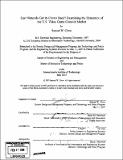| dc.contributor.advisor | James M. Utterback. | en_US |
| dc.contributor.author | Chow, Samuel W | en_US |
| dc.contributor.other | Massachusetts Institute of Technology. Technology and Policy Program. | en_US |
| dc.date.accessioned | 2008-09-03T15:29:43Z | |
| dc.date.available | 2008-09-03T15:29:43Z | |
| dc.date.copyright | 2007 | en_US |
| dc.date.issued | 2007 | en_US |
| dc.identifier.uri | http://hdl.handle.net/1721.1/42380 | |
| dc.description | Thesis (S.M.)--Massachusetts Institute of Technology, System Design and Management Program; and, (S.M.)--Massachusetts Institute of Technology, Engineering Systems Division, Technology and Policy Program, 2007. | en_US |
| dc.description | Includes bibliographical references (p. 121-125). | en_US |
| dc.description.abstract | Several generations of video game consoles have competed in the market since 1972. Overall, the entire market shares many similar characteristics, such as network effects and switching cost, which are found in other network-based markets. However, on closer examination, the video game console industry experienced several generations of technological change with each generation bringing a different competitive environment and different set of competitors from the previous one. Consistent with the Schumpeterian market model, both new and later entrants have competed successfully with their strong portfolios of technological innovations. Yet, some firms with dominant market position and strong complementary assets were not able to extend their advantage to the next generation. The dynamic cause and effect relationships associated with the multi-generation video game console industry makes an intriguing subject for economic research. This thesis provides a conceptual framework for analyzing the elements and dynamics of the competitive video game console market. Using qualitative findings and empirical data found in recent research literature on market competition and innovation, a historical analysis of the video game console market was performed. In addition, a system dynamics model was created to validate and support the analysis of the industry. The results from the simulation of the model under various competitive scenarios not only confirm some of the findings from established studies done in this area but also provide us with new qualitative insights into the dynamics operating in the market. | en_US |
| dc.description.statementofresponsibility | by Samuel W. Chow. | en_US |
| dc.format.extent | 125 p. | en_US |
| dc.language.iso | eng | en_US |
| dc.publisher | Massachusetts Institute of Technology | en_US |
| dc.rights | M.I.T. theses are protected by
copyright. They may be viewed from this source for any purpose, but
reproduction or distribution in any format is prohibited without written
permission. See provided URL for inquiries about permission. | en_US |
| dc.rights.uri | http://dspace.mit.edu/handle/1721.1/7582 | en_US |
| dc.subject | System Design and Management Program. | en_US |
| dc.subject | Technology and Policy Program. | en_US |
| dc.title | Can Nintendo get its crown back? : examining the dynamics of the U.S. video game console market | en_US |
| dc.type | Thesis | en_US |
| dc.description.degree | S.M. | en_US |
| dc.contributor.department | System Design and Management Program. | en_US |
| dc.contributor.department | Massachusetts Institute of Technology. Engineering Systems Division | |
| dc.contributor.department | Technology and Policy Program | |
| dc.identifier.oclc | 234436386 | en_US |
